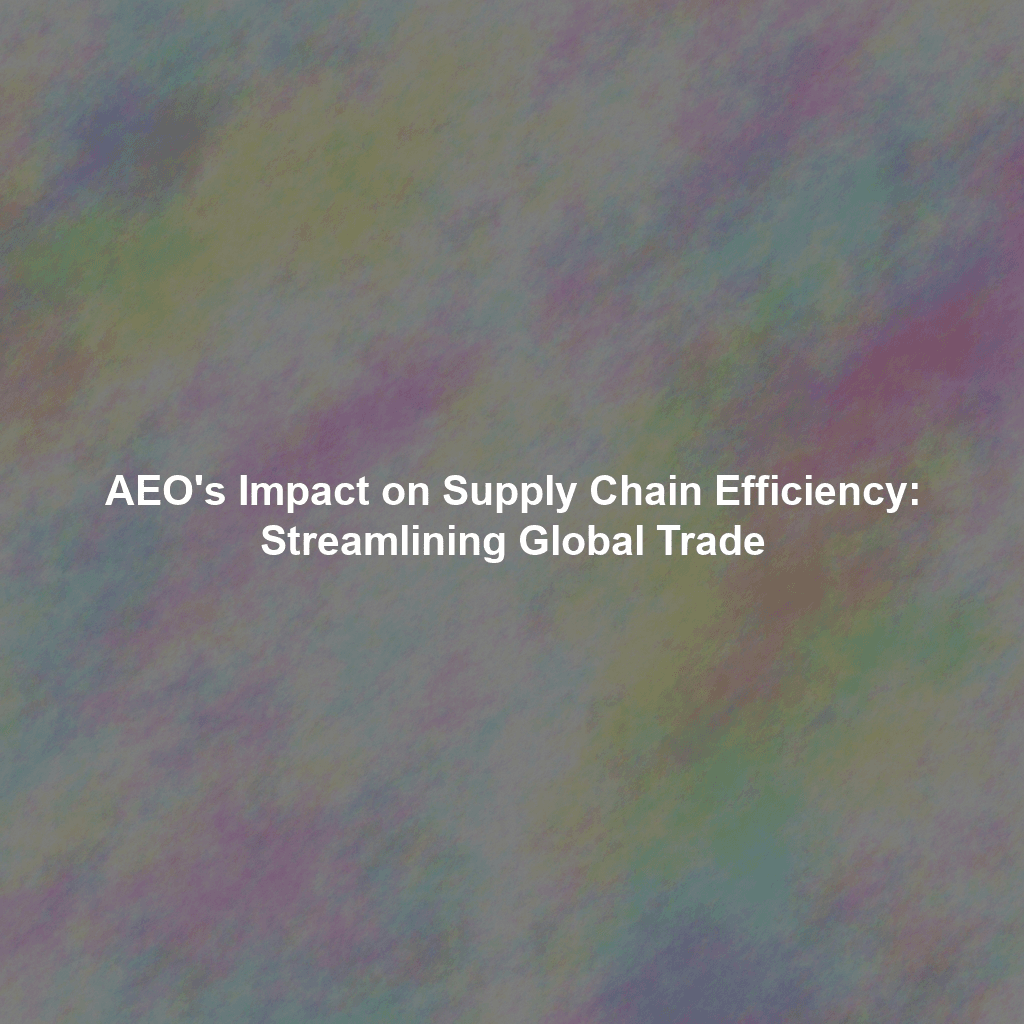Understanding AEO: A Cornerstone of Supply Chain Optimization
Authorized Economic Operator (AEO) status is a globally recognized certification awarded by customs administrations to businesses that meet specific criteria related to security, compliance, and financial solvency. Becoming an AEO-certified operator signifies a commitment to secure international trade and streamlined customs procedures. This, in turn, significantly impacts supply chain efficiency, offering tangible benefits to businesses of all sizes involved in global commerce. The AEO program is designed to facilitate trade while simultaneously enhancing security, making it a critical element for businesses seeking a competitive edge in today’s complex global marketplace. The program is implemented differently depending on the country, with the EU and the US having established programs that are well known. Understanding the nuances of the program in your relevant regions is crucial.
The Core Principles of AEO Certification
The AEO program revolves around several core principles. These include:
Security and Safety
AEO certification demonstrates a commitment to maintaining robust security measures throughout the supply chain. This includes secure premises, access control, and the vetting of partners and employees. By minimizing security risks, AEO-certified businesses contribute to a more secure global trading environment, reducing the likelihood of disruptions caused by security breaches or illicit activities. This focus on security is paramount in today’s world, where supply chains are increasingly vulnerable to threats.
Compliance with Customs Regulations
AEO certification requires rigorous compliance with all relevant customs regulations. This encompasses accurate and timely declarations, adherence to import/export rules, and the maintenance of detailed records. Compliance reduces the risk of delays, penalties, and audits, ensuring a smoother flow of goods across borders. A strong compliance record builds trust with customs authorities and facilitates efficient trade processes. This reduces the risk of costly delays and improves predictability in the supply chain.
Financial Solvency
AEO certification also assesses the financial stability of the business. This ensures that the operator can meet its financial obligations and is less likely to default on payments or abandon shipments. Financial stability is a key indicator of a reliable and trustworthy trading partner. This helps ensure the smooth operation of the supply chain and reduces the risk of financial losses.
Key Benefits of AEO Certification for Supply Chain Efficiency
AEO certification offers a multitude of benefits that directly contribute to enhanced supply chain efficiency. These benefits can translate into significant cost savings, improved operational performance, and a stronger competitive position.
Reduced Customs Clearance Times
One of the most significant benefits of AEO certification is faster customs clearance. AEO-certified businesses often receive priority treatment and are subject to fewer physical and document-based controls. This streamlined process minimizes delays at the border, allowing goods to move more quickly through the supply chain. This is particularly crucial for time-sensitive products or those with a short shelf life. According to the World Customs Organization (WCO), AEO programs can reduce clearance times by up to 50% or more in some cases. This directly translates to reduced lead times and quicker delivery to customers, improving overall customer satisfaction.
Lower Costs and Increased Predictability
Faster clearance times and reduced inspections translate into significant cost savings. Businesses can reduce storage costs, minimize demurrage charges, and optimize inventory management. The predictability of customs procedures also allows for better planning and resource allocation. The reduced uncertainty associated with customs clearance allows businesses to optimize their shipping schedules and reduce the need for buffer stock. This leads to a more efficient and cost-effective supply chain.
Enhanced Security and Reduced Risk
AEO certification significantly enhances supply chain security by implementing robust security measures throughout the supply chain. This reduces the risk of theft, smuggling, and other security breaches. This heightened security also enhances the reputation of the business and builds trust with customers and partners. The comprehensive security protocols also contribute to improved visibility and control, ensuring that goods are tracked and managed effectively throughout the entire supply chain. Reduced risk translates into reduced insurance premiums and fewer disruptions caused by security incidents.
Improved Relationships with Customs Authorities
AEO certification fosters a strong and collaborative relationship with customs authorities. This improves communication, transparency, and trust. AEO-certified businesses benefit from dedicated points of contact within customs administrations, allowing for more efficient problem-solving and access to expert advice. This collaborative approach helps businesses stay abreast of changing regulations and adapt quickly to new requirements. This positive relationship can also lead to preferential treatment and access to pilot programs, further enhancing supply chain efficiency.
Increased Competitiveness and Market Access
AEO certification provides a competitive advantage in the global marketplace. It demonstrates a commitment to best practices and a focus on efficiency and security. This can attract new customers, improve brand reputation, and facilitate access to new markets. In many countries, AEO certification is a prerequisite for participating in certain trade programs or accessing specific benefits. This helps businesses expand their reach and grow their business, especially in markets where customs compliance is paramount.
Implementing AEO: A Step-by-Step Guide for Supply Chain Professionals
Obtaining AEO certification is a comprehensive process that requires careful planning and execution. Here’s a step-by-step guide for supply chain professionals:
Self-Assessment and Gap Analysis
The first step is to conduct a thorough self-assessment to identify any gaps between current practices and the AEO requirements. This involves reviewing existing security procedures, compliance protocols, and financial records. Conduct a gap analysis to identify areas that need improvement and develop a plan to address any shortcomings. This assessment should involve all key stakeholders in the supply chain, including logistics, warehousing, and finance. This helps ensure a holistic view of the current state and identifies areas for improvement. It helps clarify the strengths and weaknesses of the current supply chain operations and identifies areas that require attention.
Develop a Comprehensive AEO Implementation Plan
Based on the gap analysis, develop a detailed implementation plan that outlines the steps required to achieve AEO certification. This plan should include specific timelines, assigned responsibilities, and resource allocation. The implementation plan should be comprehensive, covering all areas of the AEO requirements, including security, compliance, and financial solvency. The plan should be regularly reviewed and updated to track progress and ensure that all milestones are met. The plan should be communicated to all relevant stakeholders to ensure a shared understanding of the goals and objectives.
Implement Security and Compliance Measures
Implement robust security measures, including access control, personnel vetting, and secure premises. Develop and implement comprehensive compliance procedures to ensure adherence to all relevant customs regulations. This may involve updating internal policies, training employees, and implementing new technology solutions. It is important to document all procedures and maintain accurate records to demonstrate compliance. Regular audits and reviews are essential to ensure that security and compliance measures are effective. This step ensures that the necessary security protocols are in place and that all customs regulations are met.
Training and Awareness
Provide comprehensive training to all employees involved in the supply chain. This training should cover AEO requirements, security procedures, and compliance protocols. This helps ensure that all employees understand their roles and responsibilities in maintaining AEO status. A culture of awareness is critical to the success of the AEO program. Training should be ongoing to keep employees informed of any changes in regulations or procedures. Training should cover all aspects of AEO requirements, including security, compliance, and financial solvency. Regular refresher courses are also important to reinforce the principles of the AEO program.
Application and Audit
Once all requirements are met, prepare and submit the AEO application to the relevant customs authority. The application process typically involves providing detailed information about the business, its supply chain, and its security and compliance measures. The customs authority will conduct an audit to verify that the applicant meets the AEO criteria. Be prepared to cooperate fully with the audit process and provide all necessary documentation. The audit is a critical step in the certification process, and it is essential to be prepared for a thorough review of all aspects of the supply chain. This step involves submitting the application and preparing for the audit to demonstrate compliance.
AEO and Technology: Leveraging Innovation for Enhanced Efficiency
Technology plays a crucial role in achieving and maintaining AEO certification. Several technological solutions can streamline processes, enhance security, and improve compliance.
Warehouse Management Systems (WMS)
WMS can automate warehouse operations, improve inventory control, and enhance security. WMS solutions provide real-time visibility into inventory levels, track the movement of goods, and help to prevent theft and loss. This helps to streamline warehouse operations, reduce errors, and improve efficiency. This also allows for better tracking of goods and helps to prevent delays. WMS also helps with inventory management, reducing the risk of overstocking or understocking. Implementing a WMS is crucial for maintaining accurate records and ensuring compliance.
Transportation Management Systems (TMS)
TMS can optimize transportation routes, track shipments in real-time, and improve communication with carriers. TMS solutions provide real-time visibility into the location and status of goods, allowing businesses to monitor shipments and proactively address any issues. TMS also helps to streamline communication with carriers, reducing the risk of delays and improving efficiency. This can lead to reduced transportation costs and improved delivery times. Implementing a TMS is essential for managing transportation operations and ensuring compliance.
Customs Brokerage Software
Customs brokerage software automates customs declarations, reduces errors, and streamlines compliance. These software solutions automatically generate customs declarations, reducing the risk of errors and delays. They also help to ensure compliance with all relevant customs regulations. This helps to streamline customs procedures and reduce the time and effort required to clear goods through customs. Using customs brokerage software is essential for ensuring accurate and timely customs declarations and maintaining compliance.
Blockchain Technology
Blockchain technology can enhance supply chain transparency, improve security, and streamline documentation. Blockchain provides a secure and transparent platform for tracking the movement of goods and verifying the authenticity of documents. This helps to reduce the risk of fraud and improve trust among supply chain partners. Blockchain can also streamline documentation processes, reducing the time and effort required to manage paperwork. Implementing blockchain technology can improve supply chain transparency and enhance security, which is increasingly important in today’s global marketplace. This can also reduce the risk of counterfeit goods and enhance the overall integrity of the supply chain. See the World Economic Forum’s work on blockchain for supply chains for more insights.
Overcoming Challenges in AEO Implementation
While AEO certification offers significant benefits, businesses may encounter challenges during the implementation process. Here are some common challenges and strategies to overcome them:
Complexity and Resource Requirements
AEO implementation can be a complex and resource-intensive process. Businesses may need to invest in new technology, update existing procedures, and train employees. To overcome this challenge, it is important to develop a detailed implementation plan, allocate sufficient resources, and involve all key stakeholders. Seeking expert guidance from consultants or customs brokers can also be beneficial. Start small and prioritize the most critical areas for improvement. This helps to minimize the upfront investment and ensures a smoother transition. This also helps to break down the project into manageable phases and allows businesses to focus on the most critical aspects of the AEO requirements.
Maintaining Compliance
Maintaining AEO status requires ongoing efforts to ensure compliance with all relevant regulations and procedures. Businesses must regularly review their practices, conduct internal audits, and adapt to changing requirements. To overcome this challenge, establish a robust compliance program, including regular audits, internal reviews, and employee training. Stay informed of any changes in customs regulations and update procedures accordingly. This helps to ensure that the business maintains its AEO status and continues to benefit from the advantages of the program. This also ensures that the business is always up-to-date with the latest regulations and best practices.
Data Management and Record Keeping
AEO certification requires meticulous data management and record-keeping. Businesses must maintain accurate records of all transactions, shipments, and compliance activities. To overcome this challenge, implement a robust data management system, including electronic data storage and retrieval. Ensure that all data is accurate, complete, and accessible. Regularly review and update data management procedures to ensure that they meet AEO requirements. This helps to ensure that all records are accurate, complete, and easily accessible. This also helps to streamline the audit process and ensure that all data is readily available.
The Future of AEO and its Role in Resilient Supply Chains
The AEO program is constantly evolving to meet the changing needs of global trade. As supply chains become increasingly complex and interconnected, the role of AEO certification in promoting efficiency, security, and resilience will only grow.
Adapting to Evolving Trade Regulations
Customs regulations are constantly evolving to address new challenges and opportunities. AEO-certified businesses must stay informed of these changes and adapt their practices accordingly. This may involve implementing new technologies, updating internal procedures, and providing ongoing training to employees. The ability to adapt quickly to evolving trade regulations is essential for maintaining AEO status and ensuring that the business continues to benefit from the advantages of the program. This also helps to ensure that the business is always in compliance with the latest regulations.
Embracing Digitalization and Automation
Digitalization and automation are transforming the way supply chains operate. AEO-certified businesses should embrace these technologies to streamline processes, enhance security, and improve efficiency. This may involve implementing new software solutions, automating manual tasks, and leveraging data analytics to gain insights into supply chain performance. Embracing digitalization and automation can help businesses reduce costs, improve efficiency, and gain a competitive advantage in the global marketplace. This also allows businesses to better manage their supply chains and respond more quickly to changing market conditions. This includes adopting cloud-based solutions, AI-powered tools, and other technologies to improve efficiency and security.
Building Resilient and Sustainable Supply Chains
AEO certification contributes to building more resilient and sustainable supply chains. By promoting security, compliance, and efficiency, AEO helps businesses mitigate risks, reduce costs, and improve their environmental performance. This also helps to build stronger relationships with customers and partners and enhance the overall reputation of the business. This ensures that businesses are prepared to withstand disruptions and remain competitive in the long term. This includes adopting environmentally friendly practices, sourcing sustainable materials, and reducing waste. This will also allow businesses to build stronger relationships with their customers and partners.
Conclusion: Harnessing the Power of AEO for Supply Chain Success
AEO certification is a powerful tool for supply chain professionals and business owners seeking to optimize their global trade operations. By embracing the principles of security, compliance, and efficiency, businesses can unlock significant benefits, including reduced costs, faster clearance times, and improved relationships with customs authorities. Implementing AEO requires a commitment to best practices, a focus on continuous improvement, and a willingness to adapt to the evolving landscape of global trade. By taking the necessary steps to achieve and maintain AEO certification, businesses can build more resilient, secure, and competitive supply chains, positioning themselves for long-term success in the global marketplace. Start by assessing your current supply chain, identifying areas for improvement, and developing a comprehensive implementation plan. Then, focus on implementing the necessary security and compliance measures, training your employees, and applying for AEO certification. The rewards of AEO certification are well worth the effort, providing a pathway to streamlined trade, enhanced security, and a stronger competitive position.
 Skip to content
Skip to content

